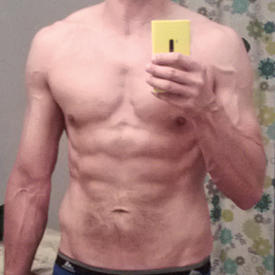MFP calorie burns from strength training way too low?
Options
Replies
-
In the context of a long term bulking or cutting phase, the way MFP is set up (i.e. eating back your exercise cals) is not the right way to go about things. Stick with the TDEE method. If you're a casual kinda, sorta whenever exerciser, then MFP's system makes perfect sense. For the aims stated in this thread, it does not.
Yes it is.
I've run through my data both with the TDEE method and the MFP method. MFP's method give a small but real increase in predictive power.
You have to be good at counting up your exercise cals, but that isn't too hard. MFP's exercise databases is in fact quite accurate, IF you are using common sense and using reasonable burns. Walking/running #'s are very accurate. Strength training is too if you use the calisthenics entries instead of the strength training entry.0 -
I've done the graphing and counting and measuring, so have a lot of people. It's a moving target, and very difficult. Then there are all the unknown and unreasearched factors to add in too. I'd say it's extremely difficult to get right.



One of these days I'll have to get around to sharing my calc spreadsheet and charts with others. I have in the past, I'll do it again eventually (PITA to prep all the GFX). Really show/explain HOW to calculate your real maintenance and show what a moving target it really is, show how it rises when bulking and falls when cutting. Show the bulking "waves". Show how to calc BF%, and compare TDEE #'s with MFP style #'s.0 -
A fitbit wouldn't really help with strength training either, as the accelerometer only tends to register steps for walking or running. It doesn't give anything extra for the calories you burn actually straining to lift.0
-
OP
do what i did. instead of guessing what your TDEE or BMR is go get it done professionally. I did at UPMC here in pittsburgh for $80
having said that i only log my eating calories through MFP. The rest i use my fitbit for as accurate a reading as possible, then adjust accordingly through a spreadsheet i keep with my cals burned/cals eaten to see where i stand0 -
In the context of a long term bulking or cutting phase, the way MFP is set up (i.e. eating back your exercise cals) is not the right way to go about things. Stick with the TDEE method. If you're a casual kinda, sorta whenever exerciser, then MFP's system makes perfect sense. For the aims stated in this thread, it does not.
Yes it is.
I've run through my data both with the TDEE method and the MFP method. MFP's method give a small but real increase in predictive power.
You have to be good at counting up your exercise cals, but that isn't too hard. MFP's exercise databases is in fact quite accurate, IF you are using common sense and using reasonable burns. Walking/running #'s are very accurate. Strength training is too if you use the calisthenics entries instead of the strength training entry.
Well, you've selectively quoted me there. I am talking about in the context of a regular training schedule. In which case, estimating burns and stuff like that is an extra step that just makes things more complicated as opposed to just picking a number (correctly or incorrectly) once and adjusting it in 2 weeks.
But, whatever. There's a million different ways to do things. Some people like things to be more complicated, some people like a more faff-free approach. I'm guessing we're both happy with the way we're doing things. The problem comes when you get people who are divorced from the real world feedback they are getting from their weigh-ins/measurement days and aren't simply adjusting up or down (or re-evaluating their intake/inputted burns) every couple of weeks as necessary. That's the point.0 -
Weight lifting calorie burn references from studies.
1 MET is about 1.2 cal / kg / hr.
Pick Conditioning references, down in list you'll find several study references to the specific lifts that were done, and though MET's are listed, they really found the calorie burn for the people involved, then using MET's came up with universal value. Which can be translated back to your own weight.
https://sites.google.com/site/compendiumofphysicalactivities/references
It's those kind of studies that the MFP and other public databases (they are usually the same though) base the info on.
But I've seen a couple of articles, started with squats I think, that more recent studies showed higher burns than past studies, so the methodology in the studies may or may not match your method of doing the lifts.0 -
OP
do what i did. instead of guessing what your TDEE or BMR is go get it done professionally. I did at UPMC here in pittsburgh for $80
having said that i only log my eating calories through MFP. The rest i use my fitbit for as accurate a reading as possible, then adjust accordingly through a spreadsheet i keep with my cals burned/cals eaten to see where i stand
Probably had an RMR test, which is neither BMR (though you can backtrack to it from RMR), nor is it TDEE.
Great way to start with best estimate though to get to TDEE, and tracking to monitor it.0 -
As others said - a HR monitor won't do a very good job of tracking calories from strength training. It's about the intensity of the workout, the stress load on your muscles, your current fitness level and properly feeding your muscles for optimum growth and recovery in between sessions.0
-
I know this isn't really anything to do with your original question, and I apologise for that, but I am curious - how does Stronglifts take an hour? I can do my sets in about 15 mins - am I doing it wrong? :laugh:
If you're completing the whole workout in 15 mins then you can't be taking the recommended rest time (the minimum being 90 seconds per set).
Say, for example, each set takes 30 seconds to complete, so 5 sets of 30 = 150 seconds actual lifting, plus four rest periods of 90 second (360 seconds) = 8 minutes 30 seconds per exercise. With three exercises (at least for workout A) that would be a minimum of 25 min 30 for the whole workout, not accounting for warm up sets and time taken to set up the weights between exercises.
You must be lifting super fast and without rest or warm ups. 0
0 -
bump0
-
I'm a female, and can burn around 2000 kcal in a day, with moderate lifts. I don't want to build muscles, just nicely defined in a feminine way. Well, needless to say that I've been eating back my exer.kcals on top of my daily allowance as well, to maintain my fitness level. Totaling a daily intake of between, 2200-3000 kcal. I am glad to say that, I'm beginning to see results in the most un expected way. The scales won't budge, but the tapemeasure does. I'm looking forward to the summer months!0
Categories
- All Categories
- 1.4M Health, Wellness and Goals
- 392K Introduce Yourself
- 43.5K Getting Started
- 259.8K Health and Weight Loss
- 175.7K Food and Nutrition
- 47.4K Recipes
- 232.3K Fitness and Exercise
- 400 Sleep, Mindfulness and Overall Wellness
- 6.4K Goal: Maintaining Weight
- 8.5K Goal: Gaining Weight and Body Building
- 152.8K Motivation and Support
- 7.9K Challenges
- 1.3K Debate Club
- 96.3K Chit-Chat
- 2.5K Fun and Games
- 3.4K MyFitnessPal Information
- 23 News and Announcements
- 991 Feature Suggestions and Ideas
- 2.4K MyFitnessPal Tech Support Questions








